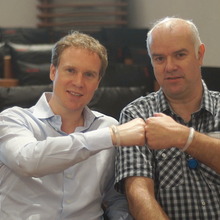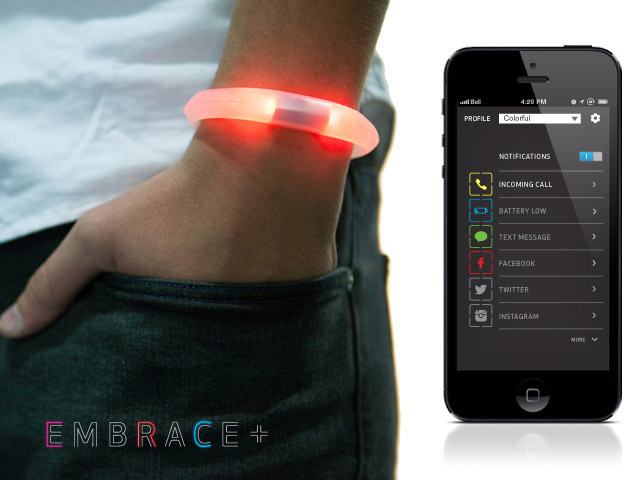This is a guest post by Rudi Beijnen. He has successfully relaunched his Kickstarter campaign with incredible success, raising over $60,000! Check it out here.
My name is Rudi and together with my friend Paul, we developed a new product called the EMBRACE+. It notifies the wearer through visual and tactile cues of incoming calls, messages, and reminders on their phone.
On February 22, 2013 we launched our first campaign, without any experience whatsoever with crowd funding and Kickstarter in particular. We put a lot of work in the prototyping but also the Kickstarter content such as a video, product photos, graphical design/illustration, and the story text.
If you have invested so much time it is a real dissapointment when you campaign fails. This happened to us. But don’t give up yet! Because Kickstarter let’s you relaunch your campaign so take the time and re-focus, re-design, and re-launch your campaign.
What did we do wrong?
1. We set a funding goal that was perceived by backers as ‘too high’. The funding goal you set is very important! If you set it too high people will think you want to make a quick buck or that your campaign will never achieve the goal. Backers want to be part of a successful campaign, not a failing one! Better you set the goal very conservative and try to go beyond it by using stretch goals and PR.
2. The video was more about us than the product. We edited all footage to 1.30min of video and most of the time the viewers saw us talking about details in difficult sentences. We were looking a bit tensioned and all this took the attention away from what it is all about: showing how a backer can benefit from your idea/product.
Therefore you should focus your video on the product, and if you have little experience in front of a camera then keep it very short and use a narration in the background while demonstrating the functionality and benefits of your product. In general: depict a phenomena/problem and present the solution/your product. Keep it simple!!! We are not all Einsteins!
3. The story you write on the Kickstarter page is also very important. Don’t use too much text, and keep it simple! The best way to go is to use a lot of graphical banners and illustrations to explains the functionality, characterictics, and benefits of your product.
4. After several days into the campaign we started to get worried we wouldn’t achieve the funding goal. Although we did pretty good the first few days, the funding goal we set was just too high. A marketing company approached us through the Kickstarter messages inbox and told us how good they are and how many other projects they helped to succeed with their social marketing campaigns. We decided to use them and looking back at this now, with the numbers analyzed, it didn’t help too much.
Nevertheless they ask a fixed fee and a percentage of the funding. Don’t do it! Looking at the statistics that Kickstarter provides we could see that the vast majority of backers came from Kickstarter itself. The marketing company did get us on many popular blogs with nice articles but it won’t attract a lot of traffic that makes a pledge. Kickstarter itself is THE source for your backers, so use a facebook and twitter account, link it to your Kickstarter page, and update it every day with a post. That should be enough…
Now the relaunch…
1. We improved all above 4 mistakes: setting a much much lower funding goal, make a new video with the focus on product demonstration and narration in background, hired a designer who improved the logo and made a lot of nice banners and illustrations for the story, and do our own marketing which only costs half an hour per day!
2. Very important: you have access to your the page of your failed campaign even after the funding has closed. You can post comments and updates which allow you to add photos, videos, and files. However, the story page cannot be edited anymore so if you know your campaign will fail then before it closes add a link (register a domain for 2 bucks or so) and use a 301 redirect to link to the relaunch page once it’s online. Anyway, STAY CLOSE WITH YOUR BACKERS! So that once you have relaunched your campaign they are willing to back you again.
3. We posted an update on the old page with a video in which we asked all backers to back our relaunch when it goes online within the first couple of days. This way we were able to achieve the 50% funding mark within two days. Result: we are shown in the popular category which rotates on the main page! This gives you an enormous amount of extra visibility.
Last comment: most people say you should keep the funding period short (not more than 30 days) to create a sense of urgency, but i don’t agree… The more time you have the more chance to get funded because each day you will receive new backers and they don’t care whether you set the goal to 30 days or 45 days.
This post is based on our first campaign which failed, and our relaunch which is currently funding:
[old] EMBRACE+, smart notification bracelet for iPhone and Android – http://kck.st/Y8arB2
[new] EMBRACE+, a smart piece of wearable technology – http://kck.st/11mrBKy
Compare them to understand my tips better, and you’ll do great with yours!
Did you find this article to be helpful? Leave a comment below or consider subscribing!






